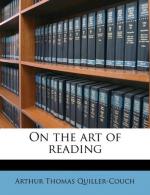Well, there you have it all: acting, singing, dancing, choral movement—enlisted ancillary to the domestic drama: and, when you start collecting evidence of these imitative instincts blent in childhood the mass will soon amaze you and leave you no room to be surprised that many learned scholars, on the supposition that uncivilised man is a child more or less—and at least so much of child that one can argue through children’s practice to his—have found the historical origin of Poetry itself in these primitive performances: ‘communal poetry’ as they call it. I propose to discuss with you (may be neat term) in a lecture not belonging to this ‘course’ the likelihood that what we call specifically ’the Ballad,’ or ‘Ballad Poetry,’ originated thus. Here is a wider question. Did all Poetry develop out of this, historically, as a process in time and in fact? These scholars (among whom I will instance one of the most learned—Dr Gummere) hold that it did: and I may take a passage from Dr Gummere’s “Beginnings of Poetry” (p. 95) to show you how they call in the practice of savage races to support their theory. The Botocudos of South America are— according to Dr Paul Ehrenreich who has observed them[1]—an ungentlemanly tribe, ‘very low in the social scale.’
The Botocudos are little better than a leaderless horde, and pay scant respect to their chieftain; they live only for their immediate bodily needs, and take small thought for the morrow, still less for the past. No traditions, no legends, are abroad to tell them of their forbears. They still use gestures to express feeling and ideas; while the number of words which imitate a given sound `is extraordinarily great’ An action or an object is named by imitating the sound peculiar to it; and sounds are doubled to express greater intensity.... To speak is ao; to speak loudly or to sing, is ao-ao. And now for their aesthetic life, their song, dance, poetry, as described by this accurate observer. ’On festal occasions the whole horde meets by night round the camp fire for a dance. Men and women alternating ... form a circle; each dancer lays his arms about the necks of his two neighbours, and the entire ring begins to turn to the right or to the left, while all the dancers stamp strongly and in rhythm the foot that is advanced, and drag after it the other foot. Now with drooping heads they press closer and closer together; now they widen the circle. Throughout the dance resounds a monotonous song to which they stamp their feet. Often one can hear nothing but a continually repeated kalani aha!...Again, however, short improvised songs, in which we are told the doings of the day, the reasons for rejoicing, what not, as “Good hunting,” or “Now we have something to eat,” or “Brandy is good."’
‘As to the aesthetic value’ of these South American utterances, Dr Gummere asks in a footnote, ’how far is it inferior to the sonorous commonplaces of our own verse—say “The Psalm of Life?"’ I really cannot answer that question. Which do you prefer, Gentlemen?—’Life is real, life is earnest,’ or ’Now we have something to eat’? I must leave you to settle it with the Food Controller.




